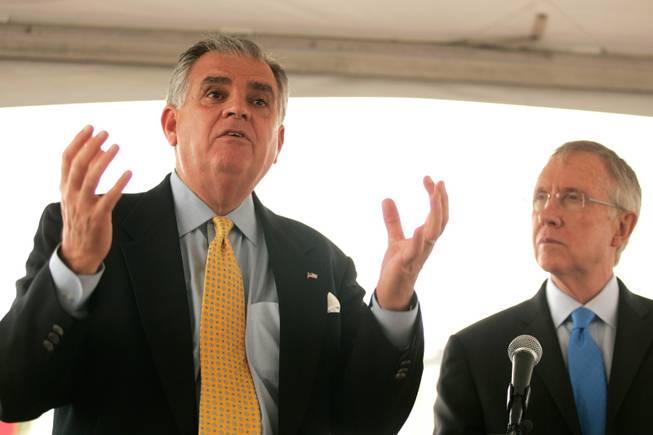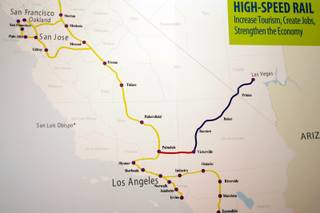
Sen. Harry Reid, right, listens as Transportation Secretary Ray LaHood speaks July 2 at a news conference to designate a high-speed-rail corridor.
Tuesday, July 14, 2009 | 2 a.m.
Reader poll
Sun Archives
- A boost for DesertXpress (7-3-2009)
- Path clears for federal support of fast train to California (7-2-2009)
- High-speed train plan gets notice in D.C. (6-24-2009)
- Public or private, rail line will need major subsidies from government (6-14-2009)
- Maglev or DesertXPress, this could be your new ride (6-14-2009)
- Trade-offs between technologies include speed, cost (6-14-2009)
- Maglev train to press on without Reid (6-10-2009)
- Reid sides with Desert Xpress fast train option (6-9-2009)
- State sends no representative to talk on high-speed trains (6-5-2009)
- Obama outlines vision for high-speed rail network (4-16-2009)
- 8 states seek stimulus money for high-speed rail (4-15-2009)
- No waste in rail dream (3-5-2009)
- Economic crisis an opportunity to be greener (3-1-2009)
- Vegas, Midwest seek the $8 billion for fast trains (2-23-2009)
A moment of truth has arrived for Nevada’s two proposed fast-train lines competing for the passenger-rich route between Las Vegas and Southern California.
On Monday Transportation Secretary Ray LaHood announced that 40 states had submitted 270 high-speed rail pre-applications seeking to qualify for stimulus money.
Will the privately backed, $5 billion DesertXpress high-speed train between Las Vegas and Victorville, Calif., seek funding, even though its backers have promised they don’t need federal dollars?
Will the publicly backed, $12 billion magnetic levitation line between Las Vegas and Anaheim push forward, even after losing the support of its chief backer, Senate Majority Leader Harry Reid, because it had taken too long to develop?
The Transportation Department is not commenting on the proposals it received by Friday’s deadline.
But a spokeswoman for DesertXpress said the project did not pre-apply for funding because it intends to remain privately funded. (The project instead will seek federal government loans, which are available for up to 100 percent of the cost.)
The maglev line’s sponsors at the California Nevada Super Speed Train Commission did submit a pre-application for the project, a spokesman said.
In the end, it remains unclear whether Nevada will get any of the $8 billion now available for high-speed rail.
The Obama administration has launched an unprecedented outlay in rail as part of the economic recovery bill passed by Congress and signed into law this year. President Barack Obama’s budget has since requested another $5 billion over the next five years to further fund rail development.
Maglev is a technology untried on rail in this country, and LaHood said he expects most of the proposals will be for high-speed rail lines similar to those now operating in Europe and Asia.
LaHood noted that maglev proposals are very expensive.
“We’re going to consider proposals that are serious proposals, that have the kind of inter-modality, multi-state, regional approach,” LaHood told reporters during a roundtable at Transportation Department headquarters.
When asked if maglev would be considered a “serious” proposal, LaHood said, “I think it’ll be serious if we get one.”
Final applications are due next month.
Reid had been a longtime backer of the maglev train proposal as he sought a rail line between Las Vegas and Southern California, but he grew frustrated with the pace of development and switched his support to the upstart DesertXpress.
Traffic on the roads and in the air between the two destinations is at capacity, and the Las Vegas tourism industry depends on the easy flow of visitors from Southern California, who make up a great portion of the Strip visitors.
In a few short years the DesertXpress project has invested $25 million on engineering plans for the line to Victorville.
Critics say the Victorville line is a train to nowhere, as the high-desert outpost is 85 miles northeast of downtown Los Angeles. But project supporters envision giving travelers a Vegas-like experience from the time they step on the train for the ride across the desert.
DesertXpress supporters also see their train one day connecting to California’s proposed north-south line that is to make a stop in Palmdale, just west of Victorville, providing a connection into downtown Los Angeles.
DesertXpress is backed by Sig Rogich, a Republican political guru in Nevada who is a Reid supporter and co-chairman of Reid’s reelection group Republicans for Reid.
In early July, LaHood designated the Las Vegas-to-Southern California route a high-speed rail corridor, enabling a proposed line to qualify for stimulus money.
Already, 10 high-speed rail corridors exist nationwide, areas determined under previous administrations as focal points for fast-train development.
But LaHood downplayed the significance of the corridor designation, saying the department is open as it judges the best projects. “Even those that maybe are not as far along as other regions will be considered,” he said.
Neil Cummings, president of the American Magline Group, the private consortium of firms that would develop the maglev line, said the commission proposed building the first, 40-mile segment between Las Vegas and Primm. The cost would be $1.6 billion.
The group also submitted a second application to the Transportation Department for planning money to continue developing the line to Anaheim.
Cummings estimates the maglev project would be jointly financed with 20 percent to 50 percent in private investment.
Organizers of both projects promise to break ground in 18 months.
DesertXpress has maintained it will not seek public funds, but may apply for loans from the federal government through a project that is separate from the recovery funds. The group expects to finance 70 percent of the cost.
Rail experts have said no private rail lines exist because they are not profitable.


Join the Discussion:
Check this out for a full explanation of our conversion to the LiveFyre commenting system and instructions on how to sign up for an account.
Full comments policy